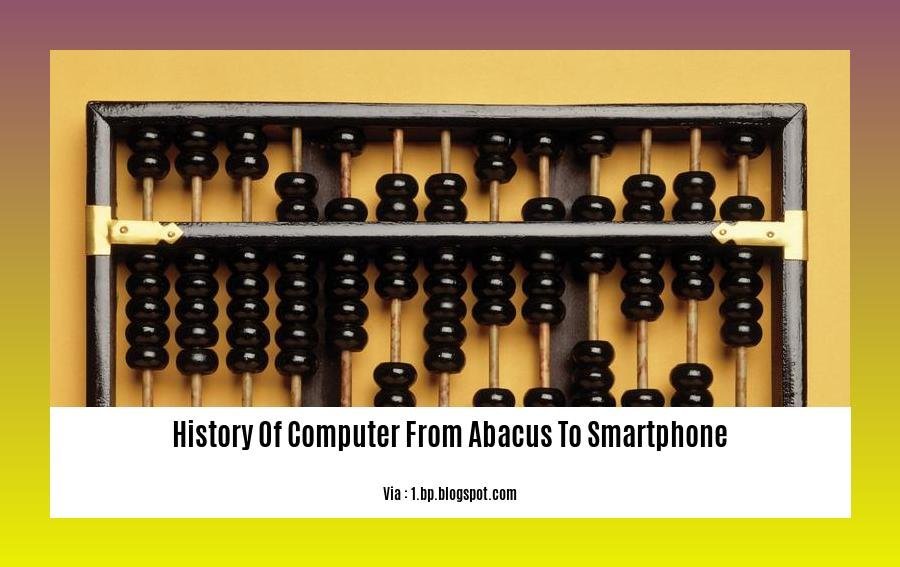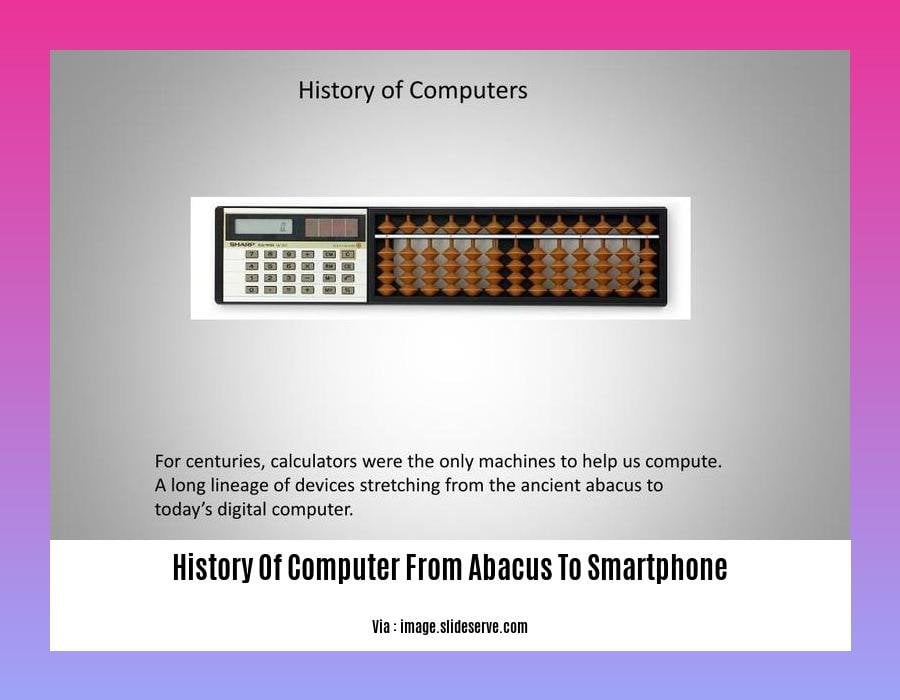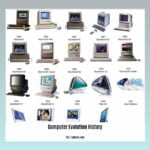In the ever-evolving world of technology, the journey of computing devices has been remarkable, shaping human civilization in countless ways. From the humble beginnings of the abacus, a simple tool used for calculations, to the sophisticated smartphones that seamlessly connect us globally, the evolution of computing has revolutionized our interactions, redefined communication, and transformed entire industries. Join us on a journey through history as we trace the remarkable evolution of computing, from the abacus to the smartphone era. [Tracing the Evolution of Computing: From the Abacus to the Smartphone Era]
Key Takeaways:
The abacus was a calculating tool, but required human operation.
Alan Turing’s Turing Test assessed a machine’s capability for intelligent behavior.
Vacuum tubes were unreliable for building computers.
Wars accelerated computing advancement, with examples being the German Z3 and American ENIAC.
The microelectronic revolution introduced transistors and integrated circuits, enabling smaller, faster, and stable computers.
Personal computers in the 1970s and the growth of the Internet in the 1990s made computing accessible to the public.
History of Computer from Abacus to Smartphone

Tracking the history of computers from abacus to smartphone is like tracing the evolution of human intellect and innovation. It chronicles the journey of machines that transformed raw computational power into sophisticated tools for solving complex problems, communicating across vast distances, and connecting individuals globally.
Ancient Calculators: The Abacus and Beyond
Before the advent of electronic computers, the abacus reigned as the primary computational tool. Its humble beads on a wire system enabled basic arithmetic operations. Later, mechanical calculators like the Pascaline and Leibniz Calculator expanded computational capabilities, paving the way for more intricate calculations.
Pioneers of Computing: Turing, Babbage, and Ada
In the early 19th century, visionaries like Charles Babbage and Ada Lovelace conceptualized the Analytical Engine, a mechanical computer capable of executing complex calculations. Alan Turing, a prominent figure in the history of computing, developed the Turing Test, a benchmark for assessing a machine’s ability to exhibit intelligent behavior.
Vacuum Tubes and Early Computers: ENIAC and Z3
The development of vacuum tubes marked a significant leap in computing history. These tubes replaced unreliable relay switches, leading to the creation of computers like the ENIAC (Electronic Numerical Integrator and Computer) and the Z3, the world’s first programmable computer. These machines, though massive in size, laid the foundation for modern computers.
Transistors and Integrated Circuits: The Microelectronic Revolution
The invention of the transistor miniaturized electronic components, leading to the development of integrated circuits (ICs). This miniaturization revolutionized computing, enabling the creation of smaller, faster, and more reliable computers. The advent of the microprocessor, a single chip containing the central processing unit (CPU), further accelerated this revolution.
Personal Computers and the Internet: A Digital Transformation
The 1970s marked the rise of personal computers (PCs) like the Altair 8800 and the TRS-80, making computing accessible to individuals and small businesses. The 1990s brought about the internet, connecting computers globally and transforming the way we communicate, access information, and conduct business.
Mobile Computing: The Smartphone Revolution
The convergence of mobile phones and computing capabilities led to the birth of the smartphone. These devices combined the functionality of a phone with the power of a computer, offering a wide range of applications, internet access, and mobile connectivity. The smartphone revolutionized communication, information sharing, and entertainment, fundamentally changing our daily lives.
Our journey through the history of computers from abacus to smartphone underscores the remarkable evolution of computing technology. From simple calculators to powerful smartphones, these devices have reshaped the way we interact with the world, demonstrating the boundless potential of human innovation.
- Interested in knowing the history of computers? Find out the intriguing journey of how computers evolved from simple calculating devices to the sophisticated machines we have today. History of Computer for Primary 2
- Curious about the history of computers in Tamil? Explore the fascinating tale of how computing technology emerged and revolutionized the way we communicate and process information.History of Computer in Tamil
- Delve into the rich history of computing with SS1, tracing the milestones from the humble beginnings of mechanical computing to the cutting-edge advancements that shape our digital world.History of Computing SS1
The Birth of the Modern Computer: ENIAC and Its Legacy

Step into the world of computing history as we explore the genesis of the modern computer, the ENIAC. This technological marvel, born out of the computational complexities of World War II, revolutionized the way we perceive and harness the power of digital computation.
Key Takeaways:
- The ENIAC, an acronym for Electronic Numerical Integrator and Computer, was the first programmable general-purpose electronic digital computer.
- It was built at the University of Pennsylvania’s Moore School of Electrical Engineering under the leadership of John Mauchly and J. Presper Eckert, Jr.
- Completed in 1946, the ENIAC weighed over 60 tons, occupied 1,800 square feet of space, and contained over 18,000 vacuum tubes, 70,000 resistors, 10,000 capacitors, and 6,000 switches.
- It was capable of performing 5,000 additions or subtractions per second, a remarkable feat at the time.
- The ENIAC was initially used to solve complex mathematical problems, including artillery firing tables and the design of hydrogen bombs.
- Beyond its practical applications, the ENIAC played a pivotal role in the development of computer programming, software engineering, and artificial intelligence.
- Its legacy continues to shape the design and development of modern computers, influencing everything from personal computers to supercomputers.
ENIAC’s contributions to the field of computing are immeasurable. It paved the way for the development of stored-program computers, where instructions and data are stored in the same memory, a concept that remains fundamental in modern computing. Moreover, it introduced the concept of parallel processing, where multiple operations are performed simultaneously, a principle that underpins the power of today’s multi-core processors.
As we marvel at the sleek, compact, and infinitely powerful computers of today, let us not forget the ENIAC, the colossal machine that blazed the trail for this technological revolution. Its legacy is a testament to human ingenuity and the relentless pursuit of innovation.
Sources:
ENIAC – Britannica
The ENIAC Legacy: Past, Present, and Future – Wharton Magazine
Microprocessors and the Personal Computer Revolution
The evolution of computing devices, from the simple abacus to the sophisticated smartphone, is a testament to human ingenuity and technological prowess. One pivotal moment in this journey was the advent of microprocessors, which sparked the personal computer revolution and transformed the way we interact with technology.
In the 1970s, the introduction of microprocessors miniaturized the processing power of computers, making them more accessible and affordable for individuals and small businesses. This groundbreaking innovation fueled the development of personal computers, such as the Apple II and the IBM PC, which brought computing power to the masses.
The impact of microprocessors extended far beyond the realm of personal computing. They revolutionized various industries, including telecommunications, transportation, and manufacturing, by enabling the development of smaller, more efficient, and intelligent devices. From smartphones to industrial robots, microprocessors became the brains behind a myriad of technological marvels.
Key Takeaways:
- The development of microprocessors in the 1970s miniaturized computer processing power, making personal computers more accessible and affordable.
- Personal computers, such as the Apple II and IBM PC, brought computing power to individuals and small businesses, transforming the way we work, communicate, and access information.
- Microprocessors revolutionized various industries beyond personal computing, enabling the development of smaller, more efficient, and intelligent devices, such as smartphones, industrial robots, and countless other technological advancements.
Sources:
- The History of the Microprocessor
- The Impact of Microprocessors on Society
The Smartphone Era: Convergence and Connectivity
Hey there, tech enthusiasts! We’re taking a deep dive into the Smartphone Era: Convergence and Connectivity, an era that has revolutionized the way we communicate, access information, and interact with the world around us.
Imagine a world without smartphones. No swiping, no tapping, no endless scrolling. Hard to picture, right? Smartphones have become an integral part of our lives, blurring the lines between technology and humanity.
In this era, the convergence of mobile phones and computing capabilities has led to a plethora of innovative applications, constant internet access, and seamless mobile connectivity. It’s not just about making calls or sending text messages anymore; it’s about having a pocket-sized computer that fits in the palm of your hand.
The smartphone revolution began with the release of the Apple iPhone in 2007, a device that set the standard for future smartphones with its revolutionary touchscreen interface and intuitive user experience. It paved the way for a new era of mobile computing, where smartphones became an indispensable tool for both personal and professional use.
Since then, the smartphone industry has seen exponential growth, with countless manufacturers releasing new models every year, each offering unique features and capabilities. From dual cameras to facial recognition, the evolution of smartphones has been nothing short of remarkable.
Key Takeaways:
Convergence of Technologies: Smartphones seamlessly merge mobile phone functionalities with computing capabilities, offering a wide range of applications, internet access, and mobile connectivity.
Touchscreen Revolution: The introduction of touchscreen interfaces revolutionized the way we interact with our devices, making them more user-friendly and intuitive.
Mobile Applications: Smartphones have given rise to a vast ecosystem of mobile applications, transforming them into portable entertainment hubs, productivity tools, and communication channels.
Global Connectivity: The integration of mobile networks and Wi-Fi connectivity has enabled smartphones to connect to the internet from virtually anywhere, fostering global communication and access to information.
Camera Evolution: Smartphones have become powerful photography tools, featuring advanced camera systems with multiple lenses, allowing users to capture high-quality photos and videos.
AI Integration: Artificial intelligence (AI) has become an integral part of smartphones, enabling features like facial recognition, voice assistants, and personalized recommendations.
Social Impact: Smartphones have had a profound impact on our social interactions, facilitating real-time communication, social media engagement, and the sharing of experiences.
Sources:
The History of Smartphones: From the First Handheld to the Modern Era
The Evolution of Smartphones: A Timeline of Innovation
FAQ
Q1: What key innovations marked the transition from mechanical to electronic computing?
A1: The shift from mechanical to electronic computing was driven by the development of vacuum tubes. These tubes replaced the mechanical relays used in early computers, enabling faster and more reliable calculations.
Q2: How did the ENIAC contribute to the advancement of modern computing?
A2: ENIAC, developed during World War II, holds a prominent place in computing history. It was the first programmable general-purpose electronic digital computer, capable of performing complex mathematical calculations at unprecedented speeds.
Q3: What role did microprocessors play in the personal computer revolution?
A3: The invention of microprocessors, such as the Intel 4004, marked a turning point in the development of personal computers. These small, powerful chips made it possible to build personal computers that were affordable and accessible to a wider audience.
Q4: How did the development of the Internet impact the evolution of computing?
A4: The rise of the Internet in the 1990s fueled the growth of personal computers and transformed the way people used them. It enabled global connectivity, access to vast amounts of information, and the emergence of new technologies like email and the World Wide Web.
Q5: What are some of the latest advancements in computing technology?
A5: Recent years have witnessed significant advancements in computing technology, including the development of artificial intelligence, machine learning, cloud computing, and the Internet of Things (IoT). These innovations are driving new applications and transforming industries across the board.
- China II Review: Delicious Food & Speedy Service - April 17, 2025
- Understand Virginia’s Flag: History & Debate - April 17, 2025
- Explore Long Island’s Map: Unique Regions & Insights - April 17, 2025

![A Journey Through the History of Computing: From Its Humble Origins to Modern Innovations [history of computing ss1] history-of-computing-ss1_2](https://www.lolaapp.com/wp-content/uploads/2023/12/history-of-computing-ss1_2-150x150.jpg)














